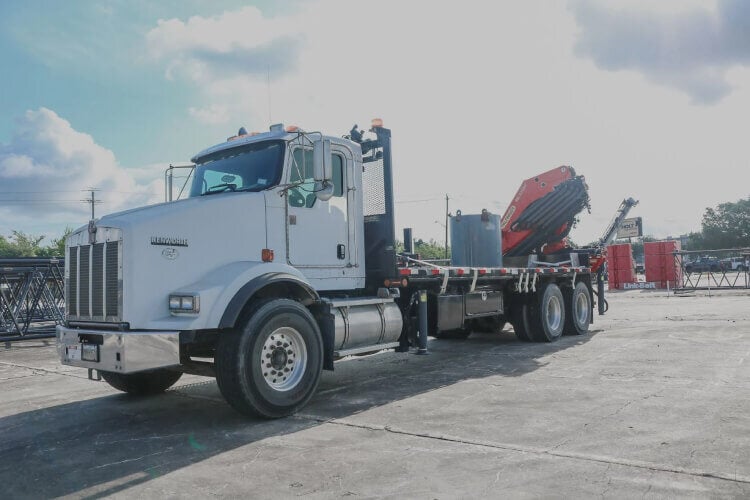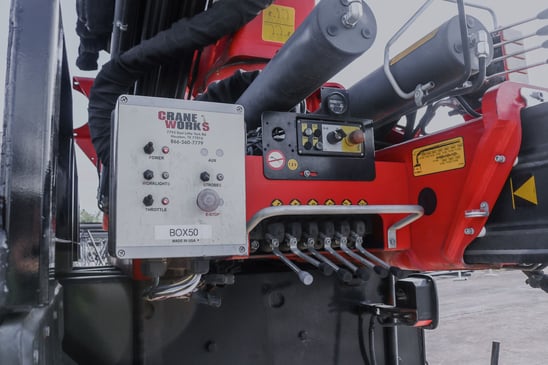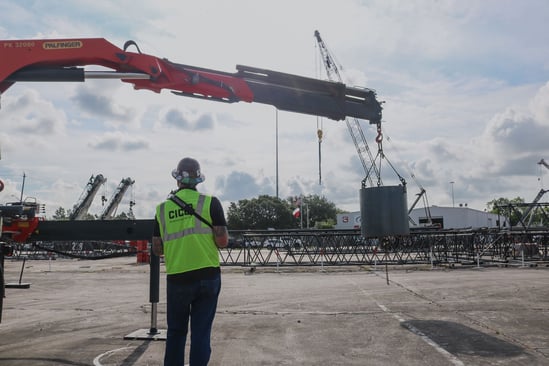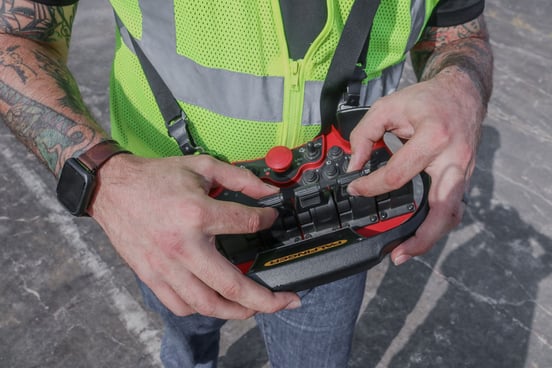
CICB has a Boom Truck Operator Training course that is customized to your company’s needs. Depending on the type of boom truck your company has, as well as its attachments, this course typically lasts two to three days, but can go up to two weeks, based on your employees’ experience. This blog first discusses everything you need to know about boom trucks, and then will provide a detailed explanation of our training program.
How is a Boom Truck Different from a Mobile Crane?
The main difference between boom trucks and mobile cranes is that boom trucks have a commercial carrier. Even though pick-and-carry cranes serve a similar purpose, the entire crane was designed and manufactured by one company. A boom truck is a boom superstructure that is designed separately and attached to a commercial carrier truck. The boom design can be either a telescopic boom or an articulating boom. If your company has an Articulating Boom Crane, we offer a separate course that specializes in knuckleboom cranes.

The operations of boom trucks vary based on the manufacturer. Fixed-cab boom trucks have either a standing platform or a remote control, while swing-cab boom trucks have a cab that is attached to the crane superstructure.
Because boom trucks are made on commercial carriers, this carrier has a different design, which limits the capacity of the crane. Current designs for telescopic boom trucks allow for capacities up to 80 tons, with a potential boom length of over 200 feet with a jib. Articulating boom trucks have a potential of up to 45 tons, with a total potential boom length of 160 feet of possible reach.
Consider that current hydraulic truck cranes can have a capacity up to 1,320 tons, with a boom length of 535 feet with a jib. When comparing the boom truck to the potential of a mobile crane, boom trucks are much smaller than other types of mobile cranes.
What is the Difference Between a Boom Truck and Articulating Boom Crane?
Telescopic boom trucks and Articulating Boom Cranes both serve the same purpose: to lift and move objects. The main difference is how the boom maneuvers. Both types can be used in the same industry; it is about the intention for use rather than line of work. Telescopic boom trucks are more similar to a mobile crane, as the boom is a straight line that moves up and down.
An Articulating Boom Crane has a knuckle (which is why it is often referred to as a “knuckleboom crane”). This gives the boom more motion capabilities, as it folds in addition to extending. An Articulating Boom Crane is slightly more complex to operate than a boom truck, but the difference is not major. Since the boom folds, it is easier to store than a telescopic boom truck.
Please also note that all classes of boom trucks can be designed with a bed and are often used for material transport/deliveries.

Who Should Operate a Boom Truck?
Although many industries use boom trucks, they are commonly used by general contractors, roofers, electrical workers, and those in construction-related environments. Many boom trucks are meant to pick up an object and lift it directly onto or from the truck. Rather than using a separate mobile crane to lift an object, the crane is built into the truck.
Kendall, an instructor at CICB, highly recommends boom truck training for those new to the lifting industry. Although having at least 20 hours of formal on-the-job training to understand the basics is ideal, he personally believes boom trucks can be simpler to operate than higher-capacity mobile cranes.
Whether your employees are experienced operators or brand-new to the lifting industry, this course is a great fit.
Similar to mobile cranes, boom trucks have load charts. However, they are much more straight-forward. Rather than having several different variables to calculate the net capacity, there are fewer variables for the boom truck load chart.
What Does Boom Truck Training Look Like?
As mentioned at the beginning of this article, this course is customizable based on the type of boom truck and any attachments. An example is if the articulating boom truck has a winch, a wire rope lesson will be incorporated into the course.
This course is designed with two major components: classroom and hands-on. At the beginning of the course, your instructor will cover all material in the textbook. Each part of the boom truck will be taught, in addition to the relevant ASME/OSHA standards. Please keep in mind that any mobile equipment with a winch or hook over one ton is considered to be a mobile crane, per OSHA.
After written material is covered, there will be hands-on training with practice. Students will learn the controls of the boom truck, which can also vary based on the type of truck. Some boom trucks operate with a remote, which is more complex since in some operating positions, the controls are backwards. (Example: If you are trying to move the boom to the left, you would press the right/east control on the remote).

At the end of the course, a written examination and hands-on evaluation will be given.
Those who pass both the written exam and evaluation will receive a certificate through CICB. This certificate demonstrates their understanding and ability to operate the equipment. It is at the employer’s discretion to accept the certificate as a qualification (only the employer has the ability to determine qualifications).
For a transferrable certification, CICB also offers a preparation course for the CCO Fixed Cab, Boom Truck, and Articulating Boom Crane Operator Examinations.
These courses teach the components of boom trucks as well as how to operate them. In addition, CICB provides a study guide to prepare for CCO’s examinations. On the last day of the course, a written and practical examination will be conducted. Upon passing both the written and practical examinations, a certification card will be issued by the CCO.
Can I Train my Employees Myself?
You might consider paying to train and qualify your Boom Truck/Articulating Boom Crane Operators to be impractical; of course, you always have the option to train your employees yourself. It is important to remember, however, that OSHA requires the operators of articulating cranes that are used to “hold, support, or stabilize material to facilitate a construction activity” to be certified by an accredited organization (all telescopic booms in construction require a certification).
If your business has unqualified operators and your boom truck is used for any activity other than general industry or transportation, you run the risk of receiving a fine from OSHA.
Lastly, improperly trained personnel can lead to accidents which cause injuries or even fatalities. Proper training teaches hazards to operators, as well as strategies for avoiding them. Investing in proper training may appear costly up front, but it is significantly more cost-effective in the long run. A trained operator will perform more smoothly and efficiently without abuse or misuse of the equipment.
If you are interested in providing training to your employees and elevating their expertise, please contact CICB by calling (800) 327-1386. You may also fill out a contact form.






